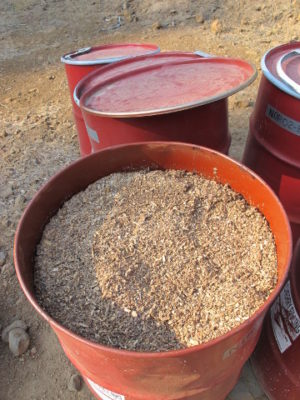
A key step in the natural organic reduction process comes at the very end. A gallon sample of the compost is sent off to a certified lab for analysis to determine its heavy-metal content and whether e.coli bacteria are present. If the results show that the material is safe to use, then the reduction process is complete, and the reduced remains can be released to the family.
We’re delighted to report that the analysis on the first three reductions is back, and not only were the key values lower than the levels set out by the Washington Department of Health–they were considerably lower. If you’d like to check out the details, here’s a link to an example of the typical results we’re seeing.
The result that stood out the most for us is the level of mercury in the compost. The maximum amount allowed is 8 milligrams per kilogram of compost–the test certified that our process produced compost that contained 0 milligrams of mercury per kilogram. You literally can’t get better than than.
As people go through life, their bodies accumulate mercury from everything from dental fillings to florescent lights. One of the main problems with using flame cremation to dispose of human remains is that cremation boils off the mercury that has accumulated in someone’s body over their lifetime. That mercury then re-enters the environment as individual atoms of mercury.
Those atoms of mercury will interact with the biosphere to form methyl mercury which is the most poisonous form of mercury. In that form, the mercury will continue to do harm. And it’s not just a problem in the present, because once mercury goes up the smoke stack, it becomes tomorrow’s problem.
Rather than exhaust the mercury into the atmosphere, we believe that it’s far better to sequester it in the clayish soil of a forest where it will do no harm.
In the case of natural organic reduction, we’re especially concerned with keeping mercury levels low because our process focuses on reducing human remains down to the atomic level. It’s not generally understood that plants can’t digest organic molecules. In order for plants to access the vital minerals locked up in dead organic materials such as fallen leaves, those materials have to be broken down to the atomic level. It’s only when that’s accomplished that the underground fungal network can transport those vital elements–magnesium, calcium, potassium, etc.–to the trees to foster new growth.
But again fungi can only transport individual atoms, not complex organic structures. So, in order to optimize the process of breaking down organic structures into atoms, we’ve modified our reduction process to support the tiny detrivores who do the actual work. Detrivores –such as the tiny springtails, creatures as small as the period on the printed page–can be thought of as nature’s undertakers. We believe that helping them do the work they evolved to do is a key part of our work.
An example of a detrivore that you’re familiar with is an earthworm. These small creatures ingest soil containing organic matter and break it down as it passes through their gut. The result is that the atoms locked up in what they’re eating become bio-available and able to grow more plants. That’s why a solution made from earthworm casings is a key resource in any organic garden. We don’t use macro-detrivores such as earthworms in our work, but we recognize that the compost we create will set the table for the micro-detrivores that will finish the work we start. In other words, the goal of our work is to create compost that will spur the microscopic detrivores to take that last step towards nourishing plant growth.
Said another way, our work isn’t focused on disposing of a body but rather on the transformation of a body into the basis for renewed growth. A key element in that process involves temperature control since most of the enzymes that do the work we want done are destroyed by high temperatures–which in the point of a process such as pasteurization. We are required by law to sterilize the compost we generate before it leaves our facility, but we don’t want to do so prematurely.
We originally planned on using a high temperature composting process to facilitate the breakdown of the bones, but based on our experience with the first few reductions, we’ve adjusted our methods and adopted a two-phase reduction process. The first phase proceeds at between 100° and 115°F, a range which allows the natural decomposition enzymes to do their work. Then during the second phase, the reduced remains are held at 131°F for at least three days to ensure that they’re free from e.coli bacteria. By doing the work in two steps, we enable the digesting bacteria ample time to do their job before the temperature is raised high enough to kill off the e.coli bacteria.
So, the solution we came up with involves doing a first phase at 100°-115° followed by a second phase at 135°-145°F. I’ll go into how we do that in the next article–A Sweet Solution.

Wynne Lee
I live near Bellingham, WA. am curious about how body would be legally transported to Herland, which is many miles away. And what happens if after testing residual mercury or other heavy metals is too high to return to the soil?